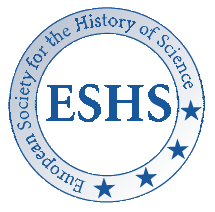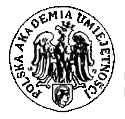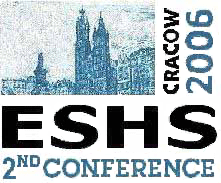Last modification: 25 September 2008
Online Book of Abstracts - A Thematic List:
SESSIONS / SYMPOSIA
Edited by Michal Kokowski
http://www.cyfronet.pl/~n1kokows/home.html
n1kokows@cyf-kr.edu.pl
Symposium R-14.
PROGRESS IN SCIENCE AND SCIENCE IN PROGRESS:
CULTURAL PERSPECTIVES
ORGANIZER AND CHAIRMAN OF THE SYMPOSIUM:
Claude Debru (Paris, France)
claude.debru@ens.fr
R-14.
A qualitative view of scientific progress (and possible regression):
What are the right questions to aks in experimental science?
Claude DEBRU (Paris, France)
claude.debru@ens.fr
In his book on Scientific Progress, the philosopher Nicolas Rescher had many interesting comments on quantitative and qualitative aspects of progress, including the varying ratio between the perceived known and the perceivde unknwon throughout history. In this paper I wish to discuss qualitative aspetcs of progress in scientific research using well defined historical examples chosen in particular scientific disciplines like neurophysiology and hematology during the second half of the twentieth century.
The hematologists Jean Bernard and Marcel Bessis devoted an entire symposium of their BloodCells Club founded in 1978 to the questions of Leukemias : What are the right questions to ask ? They insisted that in order to make progress the researcher should clearly define at each stage the kind of questions which may receive an answer which could be interpreted in a reasonable way and allow further progress. These kinds of questions may be defined as decidable questions. Asking good questions in experimental science is surely an important part of progress. The process of rephrasing the questions and reformulating the results may be considered as an essential part of real progress. However, this does not give a fair account of regression in experimental science which is also part of the picture. Sometimes the researcher is engaged in dead ends, or in false avenues, so that there is an internal dialectic between progress and regression in experimental science, which has to be considered in a realistic way to give a complete account of scientific progress. Negative answers to good questions, disproof and false avenues are part of the progress, but one should not forget in experimental science that disproof is not something totally established and that old and already abandoned concepts may gain af least some new role during the evolution of scientific models.
R-14.
Erratic progresses - Model of the erraticism
Jean-Gabriel GANASCIA (Paris, France)
Jean-Gabriel.Ganascia@lip6.fr
It is now a commonplace to point out both a speed up of time and an increasing complexity of the world. Nobody contests the acceleration of the scientific and technology production and the considerably growing amount of new results. At first sight, it has to decrease the distance beyond which it is hazardous to make previsions. However, in the field of IST - Information Science and Technology - things are not so obvious. In a way, even if it can be surprising, the upcoming future is more difficult to predict than long term future.
More precisely, a retrospective look on the IST history proves that short and mid term anticipations, i.e. five or seven years forecasts, where very often denied, while many long terms previsions are achieved. For instance, let us catch a glance on the history of cybernetics, automatic translation, artificial intelligence, expert systems, virtual realities, communication networks, minicomputers, microcomputers, web etc. We regularly mistook about the evolutions and the social consequences of those techniques. Meanwhile, many long term predictions, at 20, 30 or 40 years, carried out in accordance with the anticipations. To be convinced, one can read 1950 Alan Turing anticipations, in his famous paper about machine intelligence, or 1979 Jean-François Lyotard's book relative to the status of knowledge in the post-modern societies etc.
This difficulty to forecast imminent evolutions comes simultaneously from the multiplicity of actors participating to decisions and from the generalized interactivity. Indeed, social interactivity is becoming crucial in the high technology developments - especially in the IST field -; social practices play a more and more important role in the design process. The success of "user-center design" in information technology is a sign of this evolution. However, since retroactions come constantly and modify anticipations, planning production turns out to be far more difficult. As a consequence, short term predictions happen to be very hazardous.
Let us now suppose that, to understand the causes of this paradox, we attempt to model the evolutions. One has to consider neither one isolated promoter - the chief engineer -, nor an interdependent group of people acting solidary - the producers -, but a set of actors - including both different producers and consumers - interacting mutually each others, with dissimilar competencies and different goals. It follows that laws of change don't anymore obey to classical causality, where the effect occurs as a consequence of the cause; one has to consider all possible retroactions, which necessitates to have recourse to the dynamic system theory where short term behaviors may be chaotic whereas long term evolution converge to attractors. Briefly speaking, one can clearly explain this strange above mentioned phenomenon according which short term forecasts are more hazardous than long terms predictions, by making reference to dynamic system theory. Even if we do not pretend to reach a science or a theory of scientific progresses, we are at least able to propose a model, which enlighten the erratic character of predictions.
R-14.
Science, Mennonites and Dissent in the Dutch Enlightenment
Ernst P. HAMM (Toronto, Ontario, Canada)
ehamm@yorku.ca
Mennonites are a Protestant sect that has its origins in the radical or left wing of the Reformation. For much of their history Mennonites have been associated with agricultural communities that abandoned urban, mainstream and secular society. Yet this image, whatever accuracy it may have for specific times and places, stands in sharp contrast to eighteenth-century Dutch Mennonites who were assimilated to urban life. This was especially true in Amsterdam, where they were a well-established community actively involved in science and the promotion of science. Excluded from university positions on confessional grounds, Mennonites were nonetheless active in various branches of science and medicine, in scientific publishing, in scientific societies and in their own institutions, notably the Mennonite seminary in Amsterdam. When the seminary was founded in 1735 it had only one professor, a theologian. By 1761 it hired a second professor, one who would teach experimental natural philosophy, a field mandatory for all seminary students. Natural philosophy was not to be taught as an abstract subject, for the seminary equipped itself with an exceptional cabinet of scientific instruments, one that was probably without equal in Amsterdam and compares with the finest in the country, such as the cabinets of the Universities of Leiden and Utrecht. The seminary and its cabinet raise a number of questions of considerable interest for the history of science. Why was an institution that trained preachers for Mennonite congregations so deeply committed to experimental natural philosophy? Why were prosperous Amsterdam Mennonites willing to pay substantial sums of money to fund the cabinet of instruments? While such commitments are, in part, exemplary of the claims made by Robert Merton and others about the relationship between Protestant dissenters and the promotion of science and technology, my paper argues that the Mennonite dedication to science needs to be seen in the specific context of the Dutch Enlightenment.
R-14.
Back to progress: One or more scientific paradigms
Aleksandar PETROVIC (Kragujevac, Serbia)
petral@EUnet.yu
The 17th century is the final period of the existence of the pluralism of scientific paradigms, alchemical and mechanical, which simultaneously opposed and complemented each other. The recent appearance of Newton's alchemical manuscripts, which for a long time were inaccessible, made this statement especially convincing. They witness that the great part of Newton's scientific activity was dedicated to alchemy, study of contemporary alchemical authors and their antique origins. Francis Bacon, who gave the strongest urge for the replacement of Aristotle's organon by a new one, also investigated within the frames of the alchemical paradigm. He did not see essential opposition between alchemical and his organon, since the alchemical organon was also empirical and inductive to a great extent.
In such an unrestrained competition of paradigms the European mind rapidly progressed, enabling a more diverse comprehension of the world. In the 17 century there is still an epistemological balance between tradition and progress, closely allied with both the secular continuity and utopian expectations. However, in subsequent centuries, instead of productive balance, a mechanical paradigm has prevailed, enabling reductive misinterpretations of the key 17th century scientific figures. In that way, revolution from the social field was "exported" into the realm of science and alchemy as alternative paradigm was dethroned together with the political ancien régime. In order to maintain its revolutionary legitimacy, established on the denial of the alchemical weltanschaung, the mechanical paradigm had constricted the concept of progress to a continuous separation from past delusions and continuous increase of knowledge. But it was not a lack of veracity that led to the rejection of alchemy (alchemical notions of transmutation of elements, holistic approach, mind-related experiment, symbolistic language were sui generis revived in the XX century science), but urgent ideological need of establishing "new science" for "new society". New cultural archetype was inaugurated and its principal apology was hermeneutics of progress which set up science as a prime mover of cultural changes.
The idea of this article is to propose reconsidering of the 17th century epistemological pluralism in order to balance rapid science-driven cultural progress with integral Newtonian approach based on symbolistic, alchemical heritage.
R-14.
How does knowledge accumulate?
Circulation-processes in a long-term perspective
Henk WALS (The Hague, The Netherlands)
henk.wals@huygensinstituut.knaw.nl
In my paper the main argument is that the study of the circulation of knowledge possibly will benefit by taking account of the cumulative character of knowledge, while, on the other hand, the subject of knowledge-accumulation, which is now primarily explored by economic historians, probably has something to gain by the added expertise of the historians of science and scholarship.
The historians of science and scholarship went through some interesting conceptual changes over the last decades, moving from the classic view on the development of scientific knowledge as a series of self-initiating, self-actualizing and self-sustaining epistemological "revolutions" to a far more sophisticated approach wherein science was considered as a practical activity, not only located in the social, economical and cultural context of the place and period, but also in the routines of everyday life. This turn to micro-history was part of a trend in the historical debate, as well as of what was happening in the humanities more generally. At the same time the scope was broadened from the science practiced by people in white coats in laboratories (or their forerunners) to the production of knowledge more generally, including forms of tacit and practical knowledge produced by craftsmen and other non-scientists.
... Elaborating on the problem of accumulation of knowledge I will argue that knowledge accumulates in two ways. Firstly, to use a computer metaphor, through the expansion of the internal memory, in other words the heads of people. Assuming the capacity per head did not change much over the last millennia, the growing stock of knowledge had to be divided over more heads, which was made possible by population growth. Dividing the storage, people concentrated on more and more restricted segments of expertise, as is shown for example by the emergence of the trade of "scientist" in the early modern period and the ongoing subdivision and fragmentation of the sciences since then. This process of subdividing influenced the way knowledge circulated. Specialization generates the need for coordination, aggregation, synthesization and dissemination of information.
Secondly, we need to consider the role of the "external memory": libraries, archives, museums, encyclopedias, databases and so on. As the stock of knowledge grew, codification took place, access systems were designed and formal institutions like libraries were erected to store and manage the growing external knowledge system. To have access to previous stored information has always been crucial to scholarship and science, and became more crucial as specialization went on. Information brokers like librarians became an important link in circulation processes.
R-14.
On the relationship between the natural and the human sciences: Energetic Sociology
Frank Daan A. WEGENER (Utrecht, The Netherlands)
f.d.a.wegener@phys.uu.nl
During the decades around the turn of the twentieth century, the relationship between the natural and the human sciences was subject of intense negotiation. Familiar 'revolt against positivism' (Hughes) narratives neither explain nor accurately describe this process. Typically these accounts assume a natural distinction between the natural and the human sciences. Their present configuration was merely waiting to be found. But if these distinctions are self-evident, then how could they have been a subject of conflict? Surely such accounts are either teleological or contradictory.
The case of the 'sociologist' Georg Simmel shows how ambiguous the relations between the natural sciences and the moral sciences were. He used scientific theories and metaphors throughout his work. Especially the concept of energy and its conservation were frequently employed by Simmel, and in a number of ways.
On a fundamental level, he believed that the law of energy conservation posed problems to common sense mind-body dualism. He argued that these problems could only be solved by introducing an altogether different concept of volition. In different ways, Helmholtz and Wundt had used theories of the relation between the mind and soul, to draw boundaries between different domains of knowledge. In Simmel's time, such theories and their implications were highly disputed.
In a neo-Kantian fashion, Simmel further contrasted physical and historically interesting processes by contrasting the conservation of energy in nature, with the change of values in our appreciation of it. These arguments too were common, as Rickert and Windelband had urged that value-interests were necessary in history, and absent in physical science. Such a contrast could then be used to draw boundaries between different ways of inquiring nature.
But 'energy' was also used as an analogy for money. Money functioned in modern economy as energy worked in the physical world. This was by no means a superficial analogy or metaphor. In his analysis of modern culture, Simmel urged that the connection between money and energy was in fact very profound. Indeed, throughout the nineteenth century, energy and work were central concepts in both physics and industry.
Finally, Simmel talked about 'energy' in a somewhat casual fashion when describing (mental) states of the subject. What did it mean when he spoke of 'mental' or 'intellectual' energies? In the year that the Philosophy of Money appeared, Sigmund Freud published the Interpretation of Dreams in which he used concepts as 'intellectual energy' in strikingly similar manner. Were these attempts to describe personal consciousness in a scientific way?
The presentation attempts to shed new light on the relationship between the natural and the moral sciences in Germany around the turn of the twentieth century, by looking at Simmel's use of the concept of energy. Conversely I will also try to make more sense of Simmel's philosophy by placing his employment of the concept of energy in the context of contemporary philosophical discourse.




